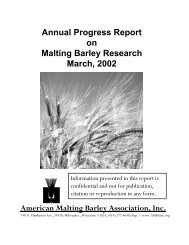Annual Progress Report on Malting Barley Research March, 2007
Annual Progress Report on Malting Barley Research March, 2007
Annual Progress Report on Malting Barley Research March, 2007
Create successful ePaper yourself
Turn your PDF publications into a flip-book with our unique Google optimized e-Paper software.
forms (through enzymolysis during malting) rather than by synthesis of new DON.<br />
Sec<strong>on</strong>d the binding of DON may represent a defense mechanism of the plant. We are<br />
currently optimizing methods for bound DON, and intend to explore the above<br />
hypothesises.<br />
(E) Cell Wall Degrading Enzymes of Fusarium graminearum (Ms Xinr<strong>on</strong>g D<strong>on</strong>g).<br />
Cell wall degrading enzymes such as cellulases and xylanases might be important in<br />
the pathogenicity of Fusarium graminearum. As such we are isolating and<br />
characterizing xylanase enzymes from Fusarium. Two xylanases have been identified in<br />
Fusarium cultures grown <strong>on</strong> wheat bran. One of the enzymes has been purified<br />
approximately 40-fold by a combinati<strong>on</strong> of ultrafiltrati<strong>on</strong>, i<strong>on</strong>-exchange and gel filtrati<strong>on</strong><br />
chromatography.<br />
(F) Use of Oz<strong>on</strong>e for C<strong>on</strong>trolling the Growth of Fusarium during <strong>Malting</strong> (Dr Dennis<br />
Tobias). Treatment of Fusarium (liquid) cultures and barley grain with gaseous oz<strong>on</strong>e at<br />
11-26 mg O3/ml for up to 2 hr was found to be effective in dramatically reducing<br />
Fusarium survival. This method will be optimized and scaled-up to evaluate<br />
effectiveness in pilot-steeping.<br />
(G) Multiplex real-time PCR for Detecti<strong>on</strong>, Identificati<strong>on</strong> and Quantificati<strong>on</strong> of<br />
Fusarium species (Dr Dennis Tobias). There has been c<strong>on</strong>siderable c<strong>on</strong>cern over a<br />
possible shift in Fusarium chemotypes, and thus associated toxin profiles and amounts.<br />
The Fusarium species associated with FHB in Midwestern barley was last extensively<br />
determined in the mid-1990’s. A major impediment to this work is the difficult and time<br />
c<strong>on</strong>suming nature of traditi<strong>on</strong>al methods for species determinati<strong>on</strong> (plating and<br />
microscopic evaluati<strong>on</strong>). The goal of this project is to develop and real-time PCR<br />
method that can be used for relatively quick and high throughput analysis of grain<br />
samples. This tool is needed both for breeding/pathology and toxicology research. The<br />
limited work to date has focused <strong>on</strong> primer selecti<strong>on</strong>.<br />
(H) Fusarium mycotoxins in Potato Tubers Infected with Fusarium Dry Rot (Mr.<br />
Javier Delgado). We are studying the mycotoxin profiles associated with Fusarium<br />
graminearum induced dry-rot of potato. These results have epidemiological implicati<strong>on</strong>s<br />
to FHB in cereals, as potato is often used in rotati<strong>on</strong> with wheat, barley, and corn.<br />
FUTURE DIRECTION OF PROGRAM<br />
Future Directi<strong>on</strong>. <strong>Malting</strong> technology is undergoing perhaps the most significant<br />
change in the past 100 years, largely through the introducti<strong>on</strong> of new process c<strong>on</strong>trol(s)<br />
methods. This technology change will demand a greater understanding of malt quality,<br />
and greater level of c<strong>on</strong>sistency in the malting barley. Methods of assessing malt<br />
89
















